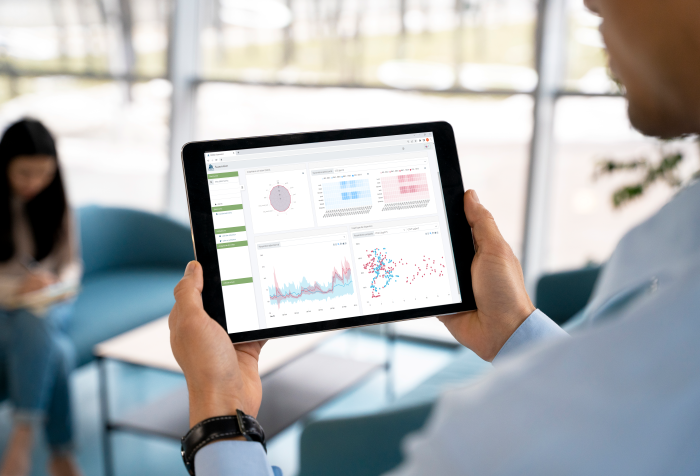BLOG
In the recent past, innovation in buildings used new materials, building methods.
Nowadays, new techs made us rethink our way to conceive and use habitable spaces.
With intelligent systems directly integrated in buildings, they became smart buildings.
Building clusters of smart buildings pave the way to smart cities, more durable and more resilient.
Smart building technology bridges the gap between the building and its users, reshaping the way we interact with our infrastructures via comfort, health, and environmental performance.
Discover below how smart building revolutionizes its future.
The term smartbuilding refers to buildings that integrate plant management technologies to optimize their energy consumption while providing a healthy and comfortable environment for users.
The smart dimension can be explained by the communicative nature of these infrastructures. Equipped with IoT devices operating in interoperability, they are able to put users directly in touch with all technical installations (heating, ventilation, lights…).

Today enriched by AI, smart buildings have gained autonomy and flexibility to make the daily lives of occupants even easier and offer them the best possible experience.
More than a simple construction, the connected building becomes a true multi-service platform, in constant dialogue with its occupants. In this way, smartbuilding represents a significant step towards more sustainable, economic and liveable infrastructures.
| Note: The concept of “smart building” refers to connected and intelligent buildings, much like home automation (domotics). However, while home automation typically applies to residential settings, smart building technology is used on a much larger scale, focusing on large commercial buildings, office spaces, and industrial sites.
Smartbuilding has many advantages.
First, the interconnectivity between different equipment and users greatly simplifies the management of the building. It allows remote control of the installations and constant monitoring of their operational status. This continuous supervision facilitates the planning of maintenance operations and thus leads to a reduction in operating costs and an extension of equipment life.
Thanks to its technical facilities optimization capabilities, smartbuilding also improves the performance of your building. This translates into a reduction in energy consumption and therefore facilitates compliance.
Finally, the smartbuilding allows to adjust the operation of equipment to the right needs of occupants. The building thus adapts to users’ preferences and their specific use of spaces, increasing their satisfaction, comfort and well-being.
IoT sensors are devices that collect different data about their environment. They provide real-time information about the building and what is happening there.
These IoT devices allow, for example, to detect:
These data are then processed and analyzed by artificial intelligence to feed control solutions for technical installations.
| Note: The Internet of Things (IoT) is a network of interconnected objects exchanging data over the Internet. The equipment can thus collect, transmit and receive information and serve to feed automation processes.
The equipment control systems, also called BMS ( Building Management System), allow to supervise and to control in an autonomous way various installations of the building. For this, they rely on the data sent by the sensors to automatically adjust the operation of the devices.
Thus, in the event that a sensor raises too high a temperature in the premises, the system can adjust the operation of the air conditioning to refresh the rooms concerned.
These systems, which offer much more precise regulation than manual programming, are today the most effective way of optimising a building’s consumption. This improves its environmental performance while providing users with a healthy and comfortable environment.
| Note: The EN ISO 52120-1 divides the different models of TBGs into
four classes (A, B, C and D) according to their regulatory capabilities. Class A TBGs are the most efficient and offer the best environmental performance where Class D models have low regulation capabilities.
Artificial intelligence is today the most suitable technology to boost the performance of buildings!
By analyzing all the data collected by IoT sensors, artificial intelligence is able to understand the behavior of the building and its occupants. This allows him to adjust his control of the equipment.
Artificial intelligence identifies patterns and trends that enable it to implement even more precise regulation of technical installations. For example, it can predict the CO2 concentration in a room based on its occupancy rate and adapt ventilation operation accordingly.
Smart buildings offer new supervisory capabilities. They allow managers to receive reports or notifications in real time or in a predictive manner related to certain parameters as well as the condition of equipment.

This facilitates the management of the building and in particular the planning of maintenance operations. In addition, through the collection and centralization of accurate data, smartbuilding provides relevant indicators to feed into an action plan aimed at constantly improving the environmental performance of the building. This data can also be used to support a CSR, environmental certification process or regulatory compliance.
Finally, web or mobile interfaces generally allow users to adjust certain settings according to their preferences and thus control aspects of their environment.
Between energy and health performance, improvement of the occupants’ well-being and reduction of the environmental footprint, smartbuilding offers many advantages for both operators and occupants.
At the same time, current European regulations promote the development of smart building. In fact, it now requires the majority of tertiary buildings to set up a BMS and gradually reduce their energy consumption.
For all these reasons, it is recommended that a technical facilities management system be adopted. Our INDALO ® Supervision solution enables predictive control, thanks to AI, of your HVAC (heating, ventilation and air conditioning) equipment and thus improves the environmental performance of your building.

Its predictive control capabilities allow it to define steering strategies adapted to your exact needs and can reduce your energy consumption up to -50%.
Contrary to what one might think, smartbuilding is not only about recent buildings! On the contrary: in order to move towards sobriety, it is better for the construction sector to focus on adapting and optimising old buildings than on building new infrastructures.
The integration of innovative technologies into old buildings makes them more efficient. To facilitate the renovation of old infrastructure and improve its environmental quality, BIM technology is recommended.

Bonjour ! C'est nous, les cookies 🍪
Nous sommes chargés de compter le nombre de visites sur ce site internet. Nous aidons énormément les personnes qui travaillent ici, car nous leur permettons d'améliorer le contenu du site internet mais aussi de rendre votre visite plus agréable.